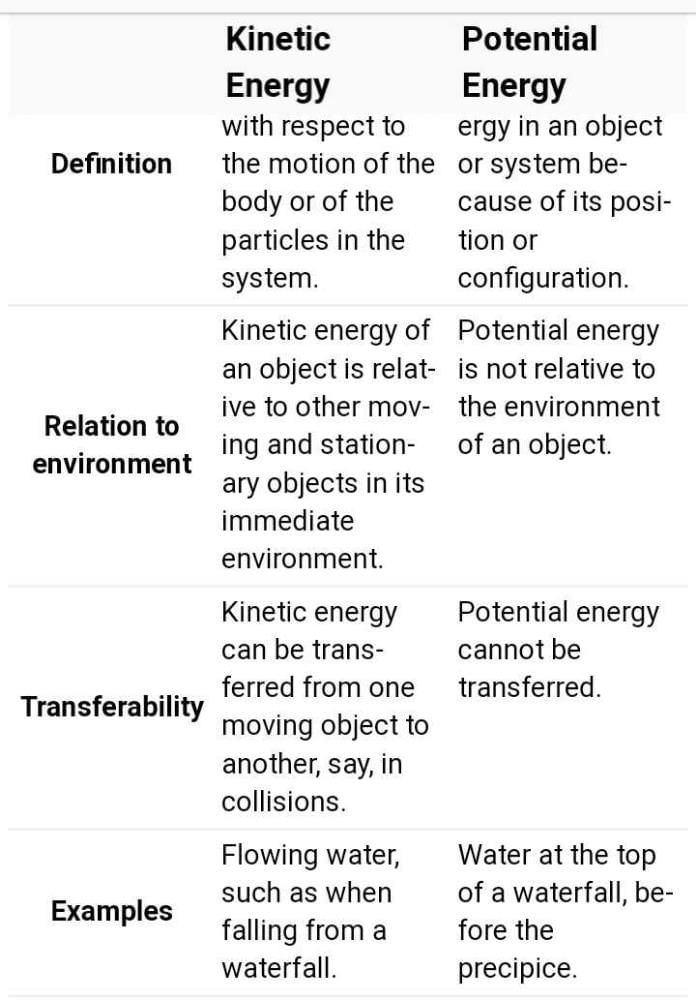Class 9 Exam > Class 9 Questions > Can anyone explain the difference between pot...
Start Learning for Free
Can anyone explain the difference between potential and kinetic energy?
Most Upvoted Answer
Can anyone explain the difference between potential and kinetic energy...
Potential vs Kinetic Energy
Definition
Potential energy is the energy that an object possesses due to its position or state. Kinetic energy is the energy that an object possesses due to its motion.
Formula
The formula for potential energy is PE = mgh, where m is the mass of the object, g is the acceleration due to gravity, and h is the height of the object above a reference point. The formula for kinetic energy is KE = 1/2mv^2, where m is the mass of the object and v is its velocity.
Examples
An example of an object with potential energy is a ball sitting on top of a hill. The higher the hill, the more potential energy the ball has. An example of an object with kinetic energy is a ball rolling down the hill. The faster the ball is rolling, the more kinetic energy it has.
Conversion
Potential energy can be converted into kinetic energy and vice versa. For example, when the ball on top of the hill rolls down, its potential energy is converted into kinetic energy. When the ball comes to a stop at the bottom of the hill, its kinetic energy is converted back into potential energy.
Importance
Understanding potential and kinetic energy is important in many fields, including physics, engineering, and everyday life. It helps explain how objects move and interact with each other, and it is used in many practical applications, such as designing roller coasters and calculating the energy needed for space travel.
Community Answer
Can anyone explain the difference between potential and kinetic energy...

Attention Class 9 Students!
To make sure you are not studying endlessly, EduRev has designed Class 9 study material, with Structured Courses, Videos, & Test Series. Plus get personalized analysis, doubt solving and improvement plans to achieve a great score in Class 9.

|
Explore Courses for Class 9 exam
|

|
Similar Class 9 Doubts
Can anyone explain the difference between potential and kinetic energy?
Question Description
Can anyone explain the difference between potential and kinetic energy? for Class 9 2024 is part of Class 9 preparation. The Question and answers have been prepared according to the Class 9 exam syllabus. Information about Can anyone explain the difference between potential and kinetic energy? covers all topics & solutions for Class 9 2024 Exam. Find important definitions, questions, meanings, examples, exercises and tests below for Can anyone explain the difference between potential and kinetic energy?.
Can anyone explain the difference between potential and kinetic energy? for Class 9 2024 is part of Class 9 preparation. The Question and answers have been prepared according to the Class 9 exam syllabus. Information about Can anyone explain the difference between potential and kinetic energy? covers all topics & solutions for Class 9 2024 Exam. Find important definitions, questions, meanings, examples, exercises and tests below for Can anyone explain the difference between potential and kinetic energy?.
Solutions for Can anyone explain the difference between potential and kinetic energy? in English & in Hindi are available as part of our courses for Class 9.
Download more important topics, notes, lectures and mock test series for Class 9 Exam by signing up for free.
Here you can find the meaning of Can anyone explain the difference between potential and kinetic energy? defined & explained in the simplest way possible. Besides giving the explanation of
Can anyone explain the difference between potential and kinetic energy?, a detailed solution for Can anyone explain the difference between potential and kinetic energy? has been provided alongside types of Can anyone explain the difference between potential and kinetic energy? theory, EduRev gives you an
ample number of questions to practice Can anyone explain the difference between potential and kinetic energy? tests, examples and also practice Class 9 tests.

|
Explore Courses for Class 9 exam
|

|
Suggested Free Tests
Signup for Free!
Signup to see your scores go up within 7 days! Learn & Practice with 1000+ FREE Notes, Videos & Tests.

























